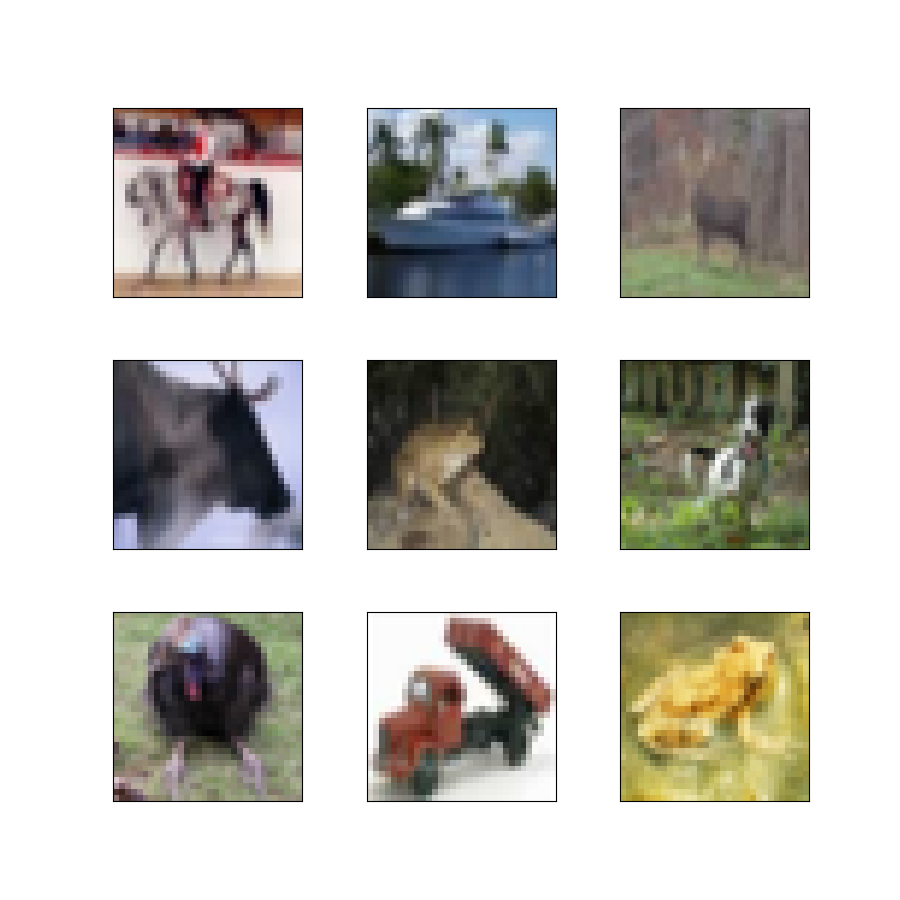- বর্ণনা :
বাস্তব মানুষের টীকা ত্রুটি সহ CIFAR-10 এর একটি পুনঃলেবেলযুক্ত সংস্করণ। আসল CIFAR-10 ট্রেন সেটে প্রতিটি জোড়ার (ছবি, লেবেল) জন্য, এটি প্রকৃত মানব টীকাকারদের দ্বারা প্রদত্ত বেশ কয়েকটি অতিরিক্ত লেবেল সরবরাহ করে।
সোর্স কোড :
tfds.image_classification.cifar10_n.Cifar10Nসংস্করণ :
-
1.0.0: প্রাথমিক প্রকাশ। -
1.0.1:worse_labelকীতে টাইপ করা হয়েছে। -
1.0.2: টীকা এবং চিত্রের মধ্যে স্থির চিঠিপত্র। - 1.0.3 :
1.0.3MANUAL_DIRফিক্সড ফাইল। -
1.0.4(ডিফল্ট): পার্শ্ব তথ্যের স্থির লোডিং।
-
ডাউনলোড সাইজ :
162.17 MiBডেটাসেটের আকার :
147.91 MiBম্যানুয়াল ডাউনলোডের নির্দেশাবলী : এই ডেটাসেটের জন্য আপনাকে ডাউনলোড_config.manual_dir-এ ম্যানুয়ালি উৎস ডেটা
download_config.manual_dirকরতে হবে (~/tensorflow_datasets/downloads/manual/ডিফল্ট):
https://github.com/UCSC-REAL/cifar-10-100n থেকে 'side_info_cifar10N.csv', 'CIFAR-10_human_ordered.npy' এবং 'image_order_c10.npy' ডাউনলোড করুন
তারপর 'CIFAR-10_human_ordered.npy' কে একটি CSV ফাইল 'CIFAR-10_human_annotations.csv'-এ রূপান্তর করুন। এটি নিম্নলিখিত কোড দিয়ে করা যেতে পারে:
import numpy as np
from tensorflow_datasets.core.utils.lazy_imports_utils import pandas as pd
from tensorflow_datasets.core.utils.lazy_imports_utils import tensorflow as tf
human_labels_np_path = '<local_path>/CIFAR-10_human_ordered.npy'
human_labels_csv_path = '<local_path>/CIFAR-10_human_annotations.csv'
with tf.io.gfile.GFile(human_labels_np_path, "rb") as f:
human_annotations = np.load(f, allow_pickle=True)
df = pd.DataFrame(human_annotations[()])
with tf.io.gfile.GFile(human_labels_csv_path, "w") as f:
df.to_csv(f, index=False)
স্বয়ংক্রিয় ক্যাশে ( ডকুমেন্টেশন ): হ্যাঁ
বিভাজন :
| বিভক্ত | উদাহরণ |
|---|---|
'test' | 10,000 |
'train' | 50,000 |
- বৈশিষ্ট্য গঠন :
FeaturesDict({
'aggre_label': ClassLabel(shape=(), dtype=int64, num_classes=10),
'id': Text(shape=(), dtype=string),
'image': Image(shape=(32, 32, 3), dtype=uint8),
'label': ClassLabel(shape=(), dtype=int64, num_classes=10),
'random_label1': ClassLabel(shape=(), dtype=int64, num_classes=10),
'random_label2': ClassLabel(shape=(), dtype=int64, num_classes=10),
'random_label3': ClassLabel(shape=(), dtype=int64, num_classes=10),
'worker1_id': int64,
'worker1_time': float32,
'worker2_id': int64,
'worker2_time': float32,
'worker3_id': int64,
'worker3_time': float32,
'worse_label': ClassLabel(shape=(), dtype=int64, num_classes=10),
})
- বৈশিষ্ট্য ডকুমেন্টেশন :
| বৈশিষ্ট্য | ক্লাস | আকৃতি | ডিটাইপ | বর্ণনা |
|---|---|---|---|---|
| ফিচারসডিক্ট | ||||
| aggre_label | ক্লাসলেবেল | int64 | ||
| আইডি | পাঠ্য | স্ট্রিং | ||
| ইমেজ | ছবি | (৩২, ৩২, ৩) | uint8 | |
| লেবেল | ক্লাসলেবেল | int64 | ||
| random_label1 | ক্লাসলেবেল | int64 | ||
| random_label2 | ক্লাসলেবেল | int64 | ||
| random_label3 | ক্লাসলেবেল | int64 | ||
| worker1_id | টেনসর | int64 | ||
| কর্মী1_সময় | টেনসর | float32 | ||
| worker2_id | টেনসর | int64 | ||
| worker2_time | টেনসর | float32 | ||
| worker3_id | টেনসর | int64 | ||
| কর্মী3_সময় | টেনসর | float32 | ||
| খারাপ_লেবেল | ক্লাসলেবেল | int64 |
তত্ত্বাবধান করা কী (দেখুন
as_superviseddoc ):Noneচিত্র ( tfds.show_examples ):

- উদাহরণ ( tfds.as_dataframe ):
- উদ্ধৃতি :
@inproceedings{wei2022learning,
title={Learning with Noisy Labels Revisited: A Study Using Real-World Human
Annotations},
author={Jiaheng Wei and Zhaowei Zhu and Hao Cheng and Tongliang Liu and Gang
Niu and Yang Liu},
booktitle={International Conference on Learning Representations},
year={2022},
url={https://openreview.net/forum?id=TBWA6PLJZQm}
}

